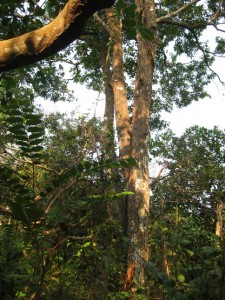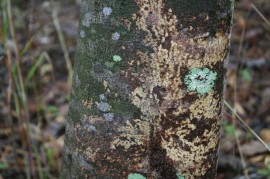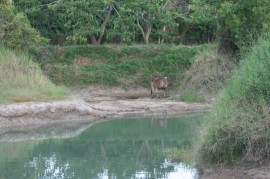Why we need trees
04:15pm, Tuesday 4 September 2012
All it takes is a small blip in the system to remind us of our dependence on nature.
When the April heat wave hit Thailand, the whole country was groaning. At our Bangkok apartment, the concrete walls were continuously warm to the touch from the sun and the throbbing air conditioners outside. As demand for electricity soared, brown-outs began and temperatures remained stubbornly high well into the night.
After five days in the city it was a relief to arrive back at Faasai and a pleasantly cool evening. But here too we were facing problems. The water at our lake had dropped more than four metres since the peak of the rainy season and some ponds were drying up. There were also ominous signs that our bore water supply at the resort was running low.
Fortunately in early May the rains came in Chanthaburi - to our relief and that of the myriads of tiny creatures that share this little piece of land with us.
The rest of the country wasn't so lucky though. Many provinces were declared disaster zones as high temperatures and late monsoon rains put the country on the verge of another crisis, barely six months after the flooding disaster of 2011.
Although floods and drought may seem like opposite problems, trees can help prevent both. A single large tree can absorb thousands of gallons of water which might otherwise end up in the storm water drains, while in the hot weather trees release mist into the atmosphere helping to stimulate the formation of clouds and rain. Perhaps this is why the drought broke sooner in our green province of Chanthaburi than in built-up urban centres such as Bangkok.
Trees also cool the environment, provide protection against gales and typhoons and filter out pollution from the air. Even on the hottest of days at the resort it is cool under the spreading branches of the bodhi tree, or in our little grove of agarwood, bananas and gingers. Our staff like to sit under the shade of the purging cassia and toothbrush tree by the gate; these lovely local trees don't only offer shade, but are part of nature's healing dispensary in Thailand. In the evenings a welcome coolness settles on the air as the hundreds of trees in our garden release oxygen into the night.
Trees also provide a haven for wild-life, refresh the human spirit, and are a valuable source of food, shelter, fodder and fuel. They also absorb carbon dioxide and release oxygen into the air.
The recent heat wave has increased my determination to plant and nurture our trees, so it was a lucky coincidence when on Saturday we visited the Chanthaburi fruit festival and were given free seedlings by the Princess Sirindhorn Foundation. They gave us eight trees, all forest giants - ton yang na (Dipterocapus alatus Roxb), ton takien (Dipterocarpaceae) and maka mong (Afzelia xylocarpa
The Royal Development Study Centre in Kung Krabaen Bay also gives away free trees to encourage people to plant them in the hope of creating a green province in Chanthaburi - another wonderful local initiative. They once gave us free vetiver grass which we planted at the resort and around our lake. The hilly province of Chanthaburi already has many forest covered hills and vast plantations of fruit and rubber trees. However, grand native trees such as the ones given away by the Princess's foundation are becoming increasingly scarce. Just two years ago, a magnificent ya nang just opposite our local temple was cut down when they widened the road.
Many tree lovers come to visit us and one recent guest Craig told me of his dream to create eco-villages shaded by forest giants:
″Owning land big enough to support beautiful old growth rain-forest climax trees must be the ultimate form of wealth. Can't eat gold!″
We certainly feel wealthy and happy thanks to our trees which are our constant companions. But we have made many mistakes in our enthusiasm for planting them. We had to cut down two fast growing rain trees after they started breaking up the concrete outside our guest rooms. Self-seeded copper pod and casuarinas close to our house also had to go as they were cracking the concrete terrace. Meanwhile a self-seeded ficus glomerata which has popped up next to our water tank, will sadly also have to go. A tall monkey jack which was one of the original trees on the property was cut down when its strong roots threatened our swimming pool, while the roots from a flowering michelia tree wrecked the plumbing in our guest bathrooms
Clearly modern houses with concrete floors don't make good companions for big trees! Fortunately our guest houses overhung by the flame trees are built on stilts. In the early days, many branches broke off during storms, but now we are protected from strong winds by the monkey jacks and bamboo growing along the boundary.
One kind of tree that is growing next to our house and not giving any trouble, is tamarind, which has lacy leaves and delicate, yet extremely strong branches. We will always remember the workers who built our house, as the tamarind stones they spat out have become a lovely grove on our north face. They flower several times a year, attracting bulbuls and sunbirds and when the fruit is ripe the trees are full of chattering squirrels.
For effective shade the west is the most important side of a house but in the tropical heat it can be quite difficult to encourage trees to grow there. On our west side the trees are growing extremely slowly so we still have to suffer the afternoon heat on that side while we wait for them to grow up. We are growing hardy local trees such as copper pod, neem, monkey jack, agarwood and bamboo which are very strong, well-adapted to the environment and will provide protection in the event of landslides.
Imagine if one day Bangkok could become a rainforest city. City residents could look over the cityscape and see parks with forest giants, green living walls of plants and gardens on the rooftops of buildings. Perhaps they could harvest the vegetables and fruit and enjoy the sight of birds and butterflies floating past their windows. How much cooler and lovelier it would be!







